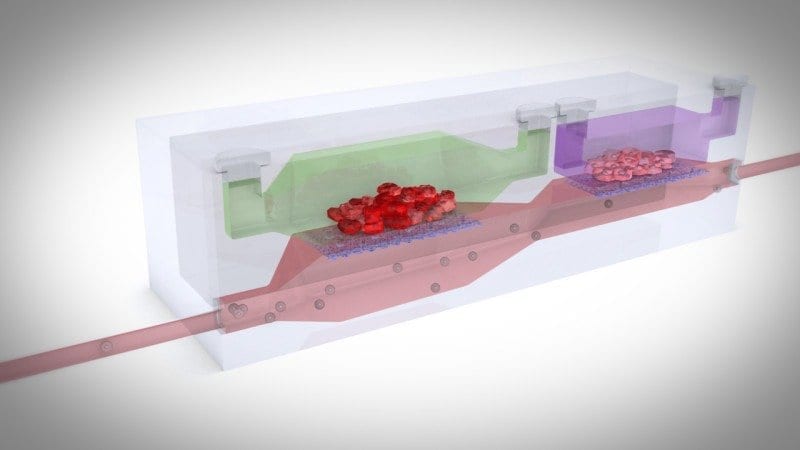Systems of this kind can help to achieve a big reduction in the cost of developing medical drugs
The recent development of the concept of organs on a chip opens the possibility of realistically studying human organs without the use of patients or animal testing. Professor Jaap den Toonder, who gave his inaugural lecture at TU/e on 20 June, even goes one step further: he intends to make microsystems in which multiple ‘organs’ are connected through ‘blood vessels’. That will for example allow precise investigation of how cancer spreads. This could eventually make the development of medical drug much cheaper and faster. TU/e is starting a special microfabrication lab to develop the required technology.
Breast cancer usually spreads to the bone marrow, the brain or the lungs. But it is hard to follow exactly how this process works – it can’t be observed directly in the human body. This is exactly the question that Jaap den Toonder, professor of Microsystems, wants to help answer, together with other Dutch institutes. Den Toonder has been involved right from the start in the development of organs on a chip, together with other researchers including Donald Ingber of the Wyss Institute at Harvard.
Systems of this kind can help to achieve a big reduction in the cost of developing medical drugs. Testing is now often carried out on human cells in Petri dishes, but these do not provide a realistic natural environment. In addition, animal tests are carried out, but these often react differently from humans. In addition, in animal tests it is not possible to observe in real-time exactly what is happening. And the fact that a medicine does not work as expected is often not discovered until it is actually tested on humans, by which time a lot of costly work may already have been done. By using a microsystem with organs on a chip, researchers will in the near future be able to perform tests much more quickly and realistically, without the need to use animals or human test subjects.
Read more . . .
The Latest on: Organ-on-a-chip
[google_news title=”” keyword=”Organ-on-a-chip” num_posts=”10″ blurb_length=”0″ show_thumb=”left”]
via Google News
The Latest on: Organ-on-a-chip
- Organ Transplants Can Change Personality and Even Sexual Orientation, Scientists Findon April 27, 2024 at 7:00 am
In a study involving 47 participants, a whopping 89 percent reported personality changes following organ transplantation surgery.
- Back in the day: We delve into our archives to see what was going on 10 years ago, 25 years ago and 50 years ago this weekon April 27, 2024 at 12:00 am
Green Watch manager at Newbury Fire Station, Richard Young, said two pumps were called at 10pm to the takeaway, which is situated in a row of shops. “The chip shop was alight with 3ft-high flames ...
- Save up to 8 lives: Become an organ donor that others might liveon April 26, 2024 at 5:23 pm
Troy Regional Medical Center held a Donate Life flag raising ceremony on the hospital grounds in recognition of April as Donate Life Month Janet Stewart, TRMC, director of marketing and communications ...
- Nearly 1,300 in Denver metro area in need of life-saving organ and tissue transplantson April 26, 2024 at 10:56 am
Donors are being honored during the month of April along with their families who agree to donate an organ, eye, and tissue.
- Who Is Mr. Robert House in FALLOUT? The History of New Vegas’ Ruler, Explainedon April 25, 2024 at 12:25 pm
The Fallout TV series' second season will surely feature Mr. Robert House, a game character who is a tech god and New Vegas ruler.
- CN Bio’s organ-on-a-chip technology boosted by £21m Series B raiseon April 24, 2024 at 9:59 pm
CN Bio is set to expand its PhysioMimix OOC (organ on a chip) technology and research services globally following the first close of a Series B investment round which has raised $21million.
- Opinion: It’s time to stop product and science testing on animalson April 24, 2024 at 3:44 am
Science has given us many marvels. Electricity immediately springs to mind, as does the telephone. The remarkable ease with which we’re able to trace our ancestry is utterly astounding, and ...
- OhioHealth honors organ donors, recipientson April 23, 2024 at 2:49 pm
OhioHealth honors organ donors, recipients. FOR MORE: ...
- CN Bio raises $21 million USD in first close of Series B investment roundon April 23, 2024 at 6:58 am
Bayland Capital and founding shareholder, CN Innovations Holdings Ltd, to invest $10 M and $5.5 M, respectively. Investment will expand product development and scaling of the organization to meet ...
- Wellington mother encourages organ donationson April 23, 2024 at 5:34 am
USD 259 leaders are trying to figure out what to do with six buildings that will close at the end of the year. It's part of a larger discussion on how to deal with the long-term needs of a district ...
via Bing News











